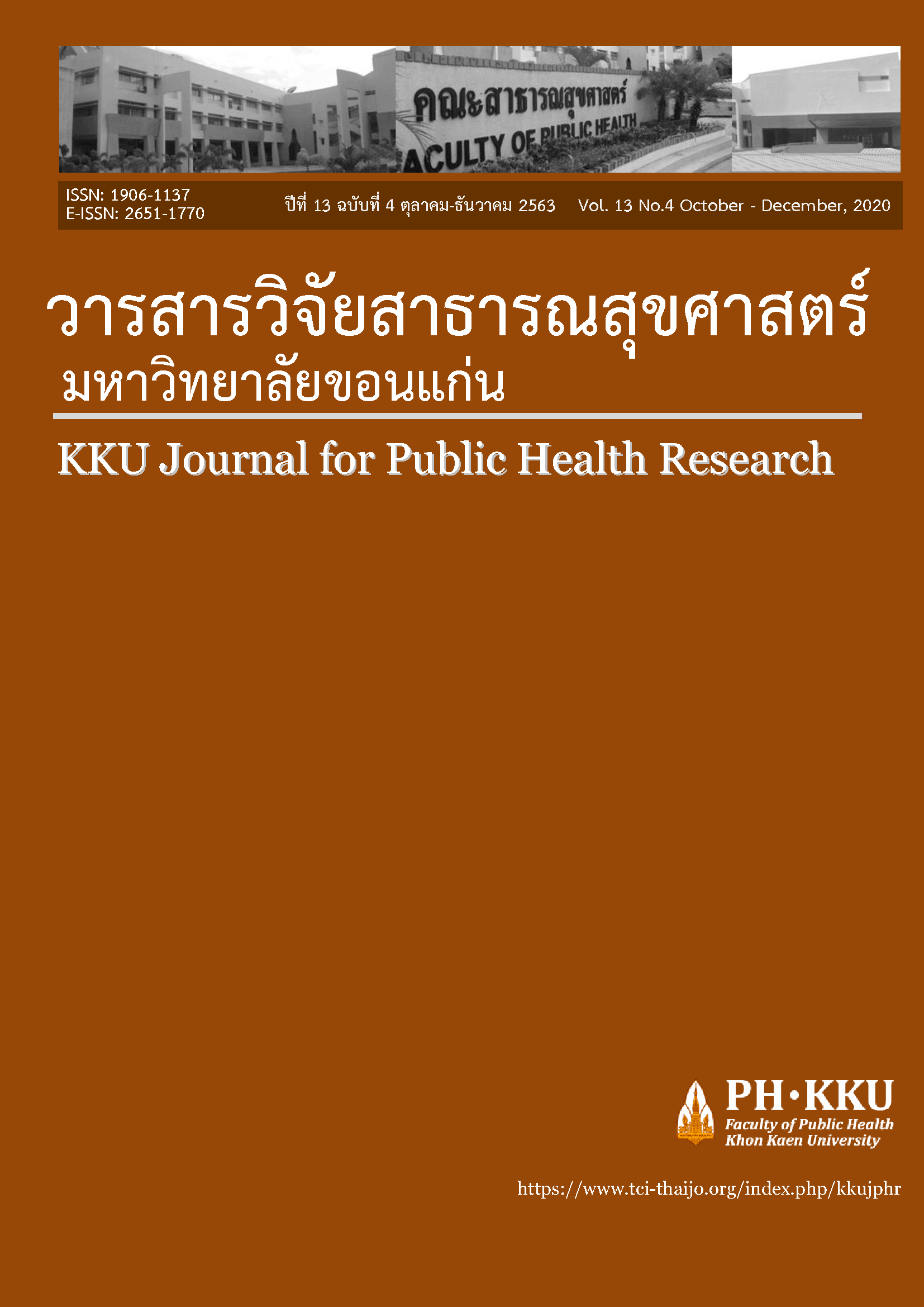ภาวะเตี้ยและปัจจัยที่มีความสัมพันธ์กับภาวะเตี้ยในเด็กอายุต่ำกว่า 5 ปี ในเมืองเวียงทอง แขวงบอลิคำไซ สาธารณรัฐประชาธิปไตยประชาชนลาว
คำสำคัญ:
ภาวะเตี้ย, เด็กอายุต่ำกว่า 5 ปี, การเลี้ยงดูเด็กด้านอาหาร, สปป.ลาวบทคัดย่อ
ภาวะเตี้ยเป็นปัญหาสุขภาพที่พบมากในเด็กอายุต่ำกว่า 5 ปีในประเทศรายได้ต่ำถึงปานกลาง รวมถึงใน สปป.ลาว การศึกษานี้จึงมีวัตถุประสงค์เพื่อ ประเมินอัตราความชุกของภาวะเตี้ยและวิเคราะห์ความสัมพันธ์ของปัจจัยด้านต่าง ๆ กับภาวะเตี้ยในเด็กอายุต่ำกว่า 5 ปี ที่อาศัยในเมืองเวียงทอง แขวงบอลิคำไซ สาธารณรัฐประชาธิปไตยประชาชนลาว (สปป. ลาว) กลุ่มตัวอย่างที่ใช้ในการศึกษาครั้งนี้ เป็นเด็กอายุต่ำกว่า 5 ปี และมารดาจำนวน 310 คน อาศัยอยู่ที่เมืองเวียงทอง แขวงบอลิคำไซ สปป.ลาว เก็บข้อมูลลักษณะส่วนบุคคล การเลี้ยงดูเด็กด้านอาหาร และสุขอนามัยส่วนบุคคล โดยการใช้แบบสัมภาษณ์ที่มีโครงสร้าง ชั่งน้ำหนักและวัดส่วนสูงเด็กและมารดา โดยผู้วิจัยที่ผ่านการอบรม ประเมินภาวะเตี้ยและเตี้ยรุนแรง โดยใช้ส่วนสูงเทียบกับอายุที่มีค่า z score (HFAz) <-2SD และ <-3SD เป็นตัวบ่งชี้ โดยอ้างอิงมาตรฐานองค์การอนามัยโลก 2006 เก็บข้อมูลเดือน มีนาคม ถึง เมษายน 2563 วิเคราะห์ความสัมพันธ์ของปัจจัยด้านต่างๆ กับภาวะเตี้ยของเด็กโดยใช้สถิติถดถอยพหุโลจิสติก ผลการศึกษาพบว่า เด็กกลุ่มตัวอย่างเป็นเพศชายร้อยละ 52.6 อายุเฉลี่ย 24.8±16.2 เดือน มารดาเด็กมีอายุเฉลี่ย 27.3±6.0 ปี เป็นชนเผ่าลาวลุ่ม ลาวสูงและลาวเทิงร้อยละ 43.6, 36.8 และ 19.7 ตามลำดับ ความชุกภาวะเตี้ยของเด็กกลุ่มตัวอย่าง พบร้อยละ 33.9 ในจำนวนนี้มีภาวะเตี้ยรุนแรงร้อยละ 11.0 ด้านการเลี้ยงดูเด็กด้านอาหารพบว่าเด็กได้รับนมแม่ทันทีหลังเกิดร้อยละ 73.9 และในช่วงอายุ 6 เดือนแรกได้รับนมแม่อย่างเดียวร้อยละ 31.9 ปัจจัยที่มีความสัมพันธ์กับภาวะเตี้ยของเด็กอย่างมีนัยสำคัญทางสถิติ ได้แก่ เด็กเพศชาย (ORadj=1.82, 95% CI: 1.08–3.06, p=0.023) เด็กกลุ่มอายุ 12–35 เดือน (ORadj=3.91, 95% CI: 1.93–7.91, p=0.001) เด็กกลุ่มอายุ 36 เดือนขึ้นไป (ORadj=4.17, 95% CI: 1.85–9.38, p=0.001) อาศัยอยู่ในชนบท (ORadj=2.11, 95% CI: 1.13–3.95, p=0.019) และเป็นชนเผ่าลาวสูง (ORadj=2.32, 95% CI: 1.22–4.41, p=0.010) โดยสรุปหนึ่งในสามของเด็กอายุต่ำกว่า 5 ปี ของเมืองเวียงทอง แขวงบอลิคำไซ สปป.ลาวมีภาวะเตี้ย ซึ่งอาจส่งผลทำให้เป็นโรคไม่ติดต่อเรื้อรังได้ในอนาคต ดังนั้นการกำหนดนโยบายและดำเนินโครงการเพื่อลดภาวะเตี้ยของเด็กในสปป.ลาว เป็นความจำเป็นเร่งด่วนด้านสาธารณสุข โดยเน้นด้านการเลี้ยงดูเด็กด้านอาหารที่เหมาะสม โดยเฉพาะอย่างยิ่งครอบครัวในชนบทที่มีลูกหลายคน และเป็นชนเผ่าลาวสูง
เอกสารอ้างอิง
Annim, S. K., & Imai, K. S. (2014). Nutritional Status of Children, Food Consumption Diversity and Ethnicity in Lao PDR, Research Institute for Economics & Business Administration, Kobe University, 17(1): 3-5. Retrieved 28 June 2019, from https:// ideas. repec.org/p/kob/dpaper/dp2014-17.html
Development Initiatives, (2018). 2018 Global Nutrition Report: Shining a light to spur action on nutrition. Bristol, UK: Development Initiatives.
de Onis, M., & Branca, F. (2016). Childhood stunting: A global perspective. Maternal &child nutrition,12(Suppl Suppl 1): 12–26.
El Kishawi, R. R., Soo, K. L., Abed, Y. A., & Muda, W. A. M. W. (2017). Prevalence and associated factors influencing stunting in children aged 2-5 years in the Gaza Strip-Palestine: A cross-sectional study. BMC Pediatrics, 17(1):210.
Fantay Gebru, K., Mekonnen Haileselassie, W., Haftom Temesgen, A., Oumer Seid, A., & Afework Mulugeta, B. (2019). Determinants of stunting among under-five children in Ethiopia: A multilevel mixed-effects analysis of Ethiopian demographic and health survey data. BMC Pediatrics, 19(1): 176.
Gebre, A., Reddy, P. S., Mulugeta, A., Sedik, Y., & Kahssay, M. (2019). Prevalence of Malnutrition and Associated Factors among under-five children in Pastoral communities of afar regional State, northeast Ethiopia: a community-based cross-sectional study. Hindawi Journal of Nutrition and Metabolism,1(1): 1-16.
Khaing, H. T., Nomura, S., Yoneoka, D., Yoneoka, D., Ueda, P., & Shibuya, K, (2019). Risk factors and regional variations of malnutrition among children under 5 in Myanmar: cross-sectional analyses at national and subnational levels. BMJ Open 2019; 9: e030894.
Khan, G. N., Turab, A., Khan, M. I., Rizvi, A., Shaheen, F., Ullah, A.,et al. (2016). Prevalence and associated factors of malnutrition among children under-five years in Sindh, Pakistan: a cross-sectional study. BMC Nutrition,2(1): 69.
Lao Statistics Bureau. (2018). Lao Social Indicator Survey II 2017, Survey findings report. vientiane, Lao PDR: Lao,1(1): 38. Retrieved 1 September 2019, from https:// lao. unfpa.org/sites/default/files/pubpdf/Lao%20Social%20Inndicator%20Survey%20II%202017-18%20%28English%29_0.pdf
Minh Do, L., Lissner, L., & Ascher, H. (2018). Overweight, stunting, and concurrent overweight and stunting observed over 3 years in Vietnamese children. Global Health Action, 11(1); 1517932.
Nshimyiryo, A., Hedt-Gauthier, B., Mutaganzwa, C., Kirk, C. M., Beck, K., Ndayisaba, A., et al. (2019). Risk factors for stunting among children under five years: A cross-sectional population-based study in Rwanda using the 2015 Demographic and Health Survey. BMC Public Health, 2019, 19(1): 175.
Prendergast, A. J., & Humphrey, J. H. (2014). The stunting syndrome in developing countries. paediatrics and international child health, 34(4): 250–265.
SAW Than Lwin. (2017). Stunting among 0-5year-old Myanmar migrant children and its associated factors in Tak province, Thailand. Thesis for the degree of Master of Public Health, Khon Kaen University, copyright of Khon Kaen University: 54–63.
Shekar, M., Kakietek, J., D’Alimonte, M. R., Rogers, H. E., Eberwein, J. D., Akuoku, J. K., et al. (2017). Reaching the global target to reduce stunting: an investment framework. Health Policy and Planning, 32(5): 657–668.
Torlesse, H., Cronin, A. A., Sebayang, S. K., & Nandy, R. (2016). Determinants of stunting in Indonesian children: evidence from a cross-sectional survey indicate a prominent role for the water, sanitation and hygiene sector in stunting reduction. BMC Public Health, 16(1): 669.
Vonaesch, P., Tondeur, L., Breurec, S., Bata, P., Nguyen, L. B. L., Frank, T., et al. (2017). Factors associated with stunting in healthy children aged 5 years and less living in Bangui (RCA). PloS One, 12(8): e0182363.
World Health Organization (WHO); Unicef. (2009).WHO Child Growth standards and the identification of severe acute malnutrition in infants and children: A joint statement by the World Health Organization and the United Nations Children’s Fund; World Health Organization (WHO): Geneva, Switzerland.
World Health Organization.(2018a). Global Nutrition Targets 2025. Reducing stunting in children: equity considerations for achieving the Global Nutrition Targets 2025. Geneva: World Health Organization. Licence: CC BY-NC-SA 3.0 IGO
Yalew BM, Amsalu F, & Bikes D. (2014). Prevalence and factors associated with stunting, underweight and wasting: A community based cross sectional study among children Age 6-59 months at Lalibela Town, Northern Ethiopia. Journal of Nutrition Disorders & Therapy, 4(2): 1000147.



